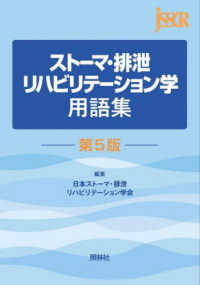- ホーム
- > 洋書
- > 英文書
- > Cinema / Film
Full Description
As the first detailed English-language book on the subject, Korean Horror Cinema introduces the cultural specificity of the genre to an international audience, from the iconic monsters of gothic horror, such as the wonhon (vengeful female ghost) and the gumiho (shapeshifting fox), to the avenging killers of Oldboy and Death Bell. Beginning in the 1960s with The Housemaid, it traces a path through the history of Korean horror, offering new interpretations of classic films, demarcating the shifting patterns of production and consumption across the decades, and introducing readers to films rarely seen and discussed outside of Korea. It explores the importance of folklore and myth on horror film narratives, the impact of political and social change upon the genre, and accounts for the transnational triumph of some of Korea's contemporary horror films. While covering some of the most successful recent films such as Thirst, A Tale of Two Sisters, and Phone, the collection also explores the obscure, the arcane and the little-known outside Korea, including detailed analyses of The Devil's Stairway, Woman's Wail and The Fox With Nine Tails. Its exploration and definition of the canon makes it an engaging and essential read for students and scholars in horror film studies and Korean Studies alike.
Contents
AcknowledgementsForeword, Julian StringerContributorsIntroduction, Alison Peirse and Daniel Martin
Part I: Classic Korean Horror1. Family, Death and the Wonhon in Three Films of the 1960s, Hyangjin Lee2. Creepy Liver-Eating Fox Ladies: The Thousand Year Old Fox and Korea's Gumiho, Alison Peirse and James Byrne3. War Horror and Anti-Communism: From Piagol to Rainy Days, Mark Morris4. Mother's Grudge and Woman's Wail: The Monster-Mother and Korean Horror Film, Eunha Oh
Part II: Contemporary 'Domestic' Horror5. Heritage of Horrors: Reclaiming the Female Ghost in Shadows in the Palace, Yun Mi Hwang6. From Acacia to Uninvited: Adoption Anxiety in Korean Horror Cinema, Hye Seung Chung7. Apartment Horror: Sorum and Possessed, Nikki J. Y. Lee8. The Face(s) of Korean Horror Film: Toward a Cinematic Physiognomy of Affective Extremes, David Scott Diffrient9. Death Bell and High School Horror, Chi-Yun Shin
Part III: Contemporary 'International' Horror10. Between the Local and the Global: 'Asian Horror' in Ahn Byung-ki's Phone and Bunshinsaba, Daniel Martin11. Diary of a Lost Girl: Victoriana, Intertextuality and A Tale of Two Sisters, Robert L. Cagle12. From A Tale of Two Sisters to The Uninvited: A Tale of Two Texts, Leung Wing-Fai13. Oldboy goes to Bollywood: Zinda and the Transnational Appropriation of South Korean 'Extreme' Cinema, Iain Robert Smith14. Park Chan-wook's Thirst: Passion, Guilt and Exsanguination, Kyu Hyun Kim
GlossaryBibliographyIndex







